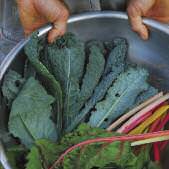edible notables
THE REAL COST
Making the paradigm shift to purchasing healthy, local food a priority.
WRITTEN BY AMANDA BURDEN, WENDY BAROLI, AND OTHER RENO FOODIES FACEBOOK GROUP MEMBERS


Often, people say they cannot afford to buy local, naturally produced food at grocery stores, farmers’ markets, or restaurants. It usually is more expensive than conventional food (which, by the way, may travel long distances to get to our eateries and markets and be sprayed with all manner of chemicals). But the issue is a matter of perspective and priorities. Consumers often find the money to pay for an expensive television and monthly television service, a latte a day, and the latest telephone. How are these extravagances more important than eating healthy food?
In a 2012 article in Mother Jones, Alyssa Battistoni wrote: “While you can debate the merits of local, organic, and seasonal food, and question what it means to eat sustainably, the dominant food production policy in the U.S. is oriented around just one metric: producing calories as cheaply as possible. We’ve gotten so good at producing calories efficiently, in fact, that our problem is no longer that we can’t afford enough food — it’s that the types of calories that are least expensive are the ones that are worst for us.”
In her article, she continued with this statement: “[People] who study our food system have pointed out, food is as cheap as it is because the true costs have been externalized — that is, we pay for them in rising obesity rates, environmental degradation, lax safety measures, and disgraceful labor practices. And if you count the money taxpayers send Big Ag in subsidies — about $292.5 billion between 1995 and 2012 — cheap food starts to seem like it might not be such a bargain after all.”
I read a recent post by the Reno Foodies Facebook group that prompted me to republish the content here (with permission). This is an important issue that requires discussion. I hope you find it enlightening. Send your thoughts on the topic to Amanda@ediblerenotahoe.com.
Wendy Baroli, farmer/owner of GirlFarm in Reno:
“I was thinking about something I often see repeated about [food being] expensive and thought this would be a great place to chat about [it].
For me, as a small local farmer, I work hard to provide a great product [and] varieties that are not only unique but not available from factory farms, confined animal feeding operations, or warehouse animal production … We ask our consumers to see what we do, to know their farmer, to participate as a consumer in understanding how good, healthy, clean food reaches their tables and favorite restaurants.
So, to the issue of pricing, I look at it this way: It takes two years just to grow out a cow [for slaughter]. It takes six months for a pig and lamb [to reach the age for harvest]. It takes six months for the very first egg to be produced, and [the chickens require] twice daily feedings. Turkeys take about seven months and meat chickens in the high desert (that are not Frankenchicken) take about 20 weeks [to reach the age for harvest]. It takes about two months for arugula, lettuce, and basic greens; three to four months for peppers and tomatoes; and fruit can be as long as four years [to reach maturity].
What I mean is a meal – not prepared on an assembly line where nonperishable parts and pieces are stored in a warehouse called up as needed — is far more valuable. And, yet, we are willing to pay far more for a product that requires far less in terms of labor, human care, and real time issues of weather, death by predators, or drought, etc.
When your favorite chef (yourself included) prepares a meal from local, non-corporate farms, you are putting local kids through college, investing in your own city coffers, and building a resilient community where we demand and expect clean, healthy food. Your dollars go so far [that] the cost of your meal turns out not to be so expensive after all.
Thank you for eating food prepared by chefs that have helped give us foodies a real food culture. And perhaps a $65 meal isn’t so expensive after all.”
Claudia Veronica Hoffmann: “Thank you! [A friend] had posted a picture of himself [on Facebook] buying veggies from an urban organic farm. Right away the first question was ‘Are the prices reasonable?’ Stop that! I worked at an organic farm. It’s hard work!”
Michelle Guerra Hinkson: “I am a firm believer in local everything. I have not shopped at that W store for a few years now because I understand what their pricing structure [is] and [what] their import philosophy does to the American worker/American farmer. Thank you for having such an honorable profession and speaking so eloquently about your passion. I think you get what you pay for. … Good produce/good meat equal a healthier person and a healthier community! … Pink slime is cheap. Good food isn’t. What do you want in your and your family’s bodies? … What I find sad is how many kids have had their young palates destroyed with fake food, additives, sodium, sugar, and chemicals [so] that these kids will choose the nugget over fresh fruit and vegetables. We owe our kids more than that.”
Christine Tierney: “This is a great way to open our eyes to the cost of our food. I’d like to add: What’s the cost of medications as opposed to eating healthy? I’d prefer to eat healthy and pay that cost or price as opposed to all the meds people are placed on for cancer and diabetes and other ailments. Eat clean and healthy.”
Erica Fink: “I never have a problem paying a higher price for good quality food.”
Kyle Weiss: “Food is hard work at every stage. Much of our ‘fast and cheap’ demands have overshadowed the important need of proper food handling, transport, and production. Cutting corners is one of the oldest tricks in the book for short-term gain, and what balances out is rife with hidden cost and unpleasant hindsight.”
Wendy Baroli: “Our next goal: to ensure that fair prices for healthily produced food can be available to all, not just those of us blessed to know there is a difference. To do that, food should contain simple unadulterated ingredients. The manufacturers’ and grocers’ associations need to get out of the lobbying business of making cheap, empty calorie food desirable with fancy wasteful packaging and high loads of salt, sugar, and fat. The most amazing things we can do are to teach a child to cook from scratch, cook with our friends, and not support entities that make food a widget. I love this group because we celebrate the most amazing human thing we can do (and is the convivial function of the most important act we can do): feed ourselves and one another and celebrate that experience!”
Dana Hopkins: “Agree! Buying locally is totally worth the price! I just wish it were more convenient, as in more stores offering locally grown options. I do buy locally grown meats and we have our own chickens for eggs, but I wish I could get other products that were grown/made locally. Convenience is an issue for me. I can’t always go to farmers’ markets or drive outside of town to pick up a CSA. How can we get more Nevada-grown products in our local stores!?”
Wendy Baroli: “The Great Basin Community Food Co-op is pretty convenient, and there is a CSA delivery there as well. [A lot of] local stores are owned and operated by out-of-state corporations. It’s a whole shift in not only how we eat and what we eat, but how we get our food as well. What if a farmer was to have a mobile market with both meats and veggies and it was parked each week at, say, some side street in walking distance to the university? What kind of commitment do you see for that sort of idea?
Dana Hopkins: “Like a food truck, only like a mobile grocer? That would be really cool! Especially for the downtown areas … Ideas like that are what help to spark change. One mobile grocer may lead to five that are able to service many areas locally!”
Kathleen Marshall: “We went to Campo for the first time last night and we appreciated every last well-thought-out detail of every dish we had. The arugula was fantastic, the meats were perfectly cooked, and every bite a revelation of what food can be. On a teacher’s salary, I can’t pay those prices every day, or even every month. But what dining at great restaurants does for us is spark our own cooking. I simply cannot buy everything from farmers’ markets all year long, but we do as much as we possibly can. The California Street market has a couple vendors who show up in all but the most inclement weather. We appreciate what our farmers and ranchers do and are willing to pay more for it. Not everyone can. On my class’ website, I posted a quote that says, ‘Wear the old coat; buy the new book.’ It’s all about priorities and, for some, priorities are rent and power and gas to get to work. I’ve been there myself. Wendy, you’re right: We need to teach people how to cook. So many inexpensive things can be made with minimal ingredients that are tasty and healthy. We’ve given so much of our power away to manufacturers who make tons of profit on chemical concoctions that people think taste good because the advertising tells them they do. In the meantime, I’m grateful that I have the wherewithal to cook great food, buy quality ingredients from people I know (organic or not), and dine out at restaurants that care about all aspects of food.”
Ted Beisler: “One thing I didn’t see mentioned here is that there are hidden costs to the cheap food you get through the industrial food chain. There are environmental costs; polluted rivers and dead zones in the ocean are two examples. Pesticide use has some health costs associated with it, and with health care changes we will all be paying these costs. … The only way to know what your food is is to know your farmer.”
Wendy Baroli: “It is wonderful to see such a group not only wanting quality but also understanding the ramifications of corporate food [on economics, health, and culture]. I freaking love Reno! It is not often you are able to actually witness a change like this in a city that has begun a true shift from a transient stopover to a city that is creating place, as geographers like to say.”



For details about the businesses listed here, visit http://www.Girlfarm.org, http://www.Camporeno.com, http://www.Greatbasinfood.coop and find listings for CSAs, farmers’ markets, and more at https://ediblerenotahoe.com


